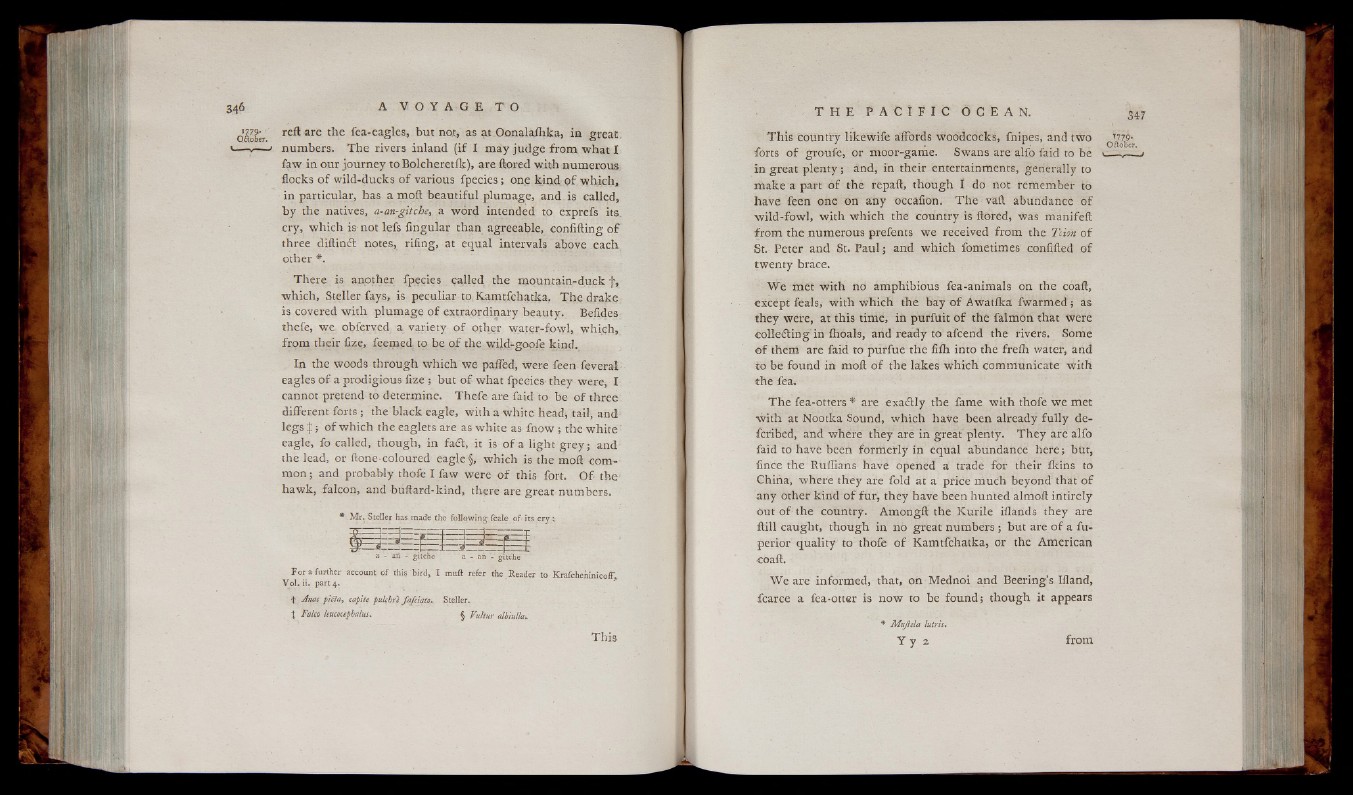
reft are the fea-eaglcs, but not, as ^t Oonalalhka, in great,
numbers. The rivers inland (if I may ju d g e from what I
faw in our journey to Bolcheretik), are ftored with numerous
flocks o f wild-ducks o f various fp e cie s; one k in d p f w hich,
in particular, has a moft beautiful plumage, and is called,
b y the natives, a-an-gitche, a word intended to exprefs its
cry, which is not lefs Angular than agreeable, conflfting o f
three diftinct notes, riflng, at equal intervals above each
other *.
There is another fpecies called the mountain-duck f ,
which, Stellar fays, is peculiar to Kamtfchatka, T h e drake
is covered w ith plumage o f extraordinary beauty. Befides
thefe, we obferved a variety o f other w ater-fowl, which,
from their flze, feetped to be o f the wijd-gopfe kind.
In the woods through which we pafled, were feen feveral
eagles o f a prodigious flze ; but o f what fpec-ies they were, I
cannot pretend to determine. Thefe are faid to be o f three
different forts ; the black eagle, with a white head* tail, and
legs | ; o f which the eaglets are as white as fnow ; the white
eagle, fo called, though, in fa it, it is o f a light g r e y ; and
the lead, or ftonecoloured eagle §, which is the moft common
; and probably thofe I faw were o f this fort. Of- the
hawk, falcon, and buftard-kind, there are great numbers.
* Mr. Steller has made the following icale of. its ery t
--------
— H--------s -------- 0) — J• = r~ : 3 " ' p ' : :
a - an - g itc h e - ah g it c h e "
For a further account of this bird, I mud refer the Reader to Krafchenimcoff,
Vol. ii. part 4.
t Anas capite pulcbre, fafciata. Steller.
} Falw lmacepbalus. § Vultur albiulla,
Th is country likewife affords woodcocks, fnipes, and two Wk'
i n . O & o b e r forts o f groufe, or moor-game. Swans are alfo faid to be '__._
in great p len ty ; and, in their entertainments, generally to
make a part o f the repaft, though I do not remember to
have feen one on any occafion. T h e vaft abundance o f
wild -fow l, with w hich the country is ftored, was manifeft
from the numerous prefents we received from the Tcion o f
St. Peter and St. P a u l; and w hich fometimes confifted o f
twenty brace.
W e met w ith no amphibious fea-animals on the cóaft,
except feals, with which the bay o f Awatfka fw a rm ed ; as
they were, at this time, in purfuit o f the falmón that Were
collecting in fhoals, and ready to afcend the rivers. Some
o f them are faid to purfue the fifh into the frefh water, and
to be found in moft o f the lakes w hich communicate with
the fea.
T h e fea-otters * are e x a ftly the fame with thofe we met
w ith at Nootka Sound, which have been already fu lly de-
fcribed, and where they aré in great plenty. T h e y are alfo
faid to have been formerly in equal abundance h e re ; but,
fince the Ruffians have opened a trade for their ikins to
China, where they are fold at a price much beyond that o f
an y other kind o f fu r , they have been hunted almoft intirely
Out o f the Country. Amongft the Kurile iflands they are
ftill caught, though in no great numbers ; but are o f a fu-
perior quality to thofe o f Kamtfchatka, Or the American
coaft.
We are informed, that, on Mednoi and Beering’s Ifiand,
fcarce a fea-otter is now to be found; though it appears
* Mujiela lutris.
Y y 2